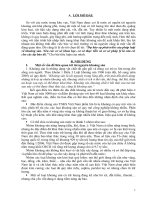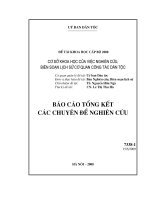chap18 personal selling 4047
Bạn đang xem bản rút gọn của tài liệu. Xem và tải ngay bản đầy đủ của tài liệu tại đây (1.03 MB, 25 trang )
18
Personal Selling
McGraw-Hill/Irwin
© 2004 The McGraw-Hill Companies, Inc., All Rights Reserved.
Determining the Role of Personal Selling
¾ What information must be exchanged between
firm and potential customer?
¾ What are the alternative ways to carry out
these communications objectives?
¾ How effective is each alternative in carrying
out the needed exchange?
¾ How cost effective is each alternative?
When the Sales Force is a Major Part of IMC
¾ Product or Service
– Complex goods or services
– Major purchase decisions
– Personal demonstration required
¾ Price
– Final price negotiable
– Price provides adequate margin
¾ Channels
–
–
–
–
Channel short and direct
Training needed by intermediaries
Selling needed to push product through
Intermediaries can provide personal selling
¾ Advertising
– Media do not provide an effective link
– Information can not be provided by media
– Sparse market make ads uneconomical
Stages of Personal Selling Evolution
Provider Stage
Selling activity limited to order-taking
Persuader Stage
Attempting to persuade customer to buy
Prospector Stage
Seeking out buyers perceived to have a need
Problem-Solver Stage
Buyers identify problems to be met by goods
Procreator Stage
Seller determines buyer needs and fulfills them
New Role of Personal Selling
The Business World in Transition
¾ Individuals and corporations are gaining
more knowledge and economic power
¾ Value is replacing efficiency
¾ Industry boundaries are changing
New Roles for Salespeople
¾ Surveying
– Educating themselves more about their customers’
businesses and regularly assessing these businesses and
their customers to achieve a position of knowledgeable
authority
¾ Mapmaking
– Outlining both an account strategy and a solutions
strategy (for the customer), laying out a plan, discussing
it with the customer, and revising it as changes require
¾ Guiding
– Bringing incremental value to the customer by identifying
problems and opportunities, offering alternative options
and solutions, and providing solutions with tangible value
¾ Fire starting
– Engaging customers and driving them to commit to a
solution
Sales People Now Assume Many Roles
Relationship Marketing
Relationship marketing is an
organization’s effort to develop a longterm, cost-effective link with individual
customers for mutual benefit
Software Providers Assist in the
Development of CRM Programs
Personal Sales Calls are Expensive
The cost of a personal sales call
ranges from $276 in the food
industry to $354 in electronics
Personal Selling Responsibilities
¾ Locating prospective customers
¾ Determining customers’ needs and wants
¾ Recommending a way to satisfy them
¾ Demonstrating capabilities of the product
¾ Closing the sale
¾ Following up and servicing the account
Types of Sales Jobs
¾ Creative Selling
– Requires the most skill and
preparation
– Must assess situation, determine
needs and make the presentation
¾ Order Taking
– This role is much more casual
– Often involves straight rebuying
¾ Missionary Sales Rep
– This is essentially a support role
where the focus is on account service
– May not actually take the order
10 Traits of Effective Salespeople
1. Ego strength: a healthy self-esteem that allows one to bounce
back from rejection.
2.
A sense of urgency: wanting to get it done now.
3.
Ego drive: a combination of competitiveness and self esteem.
4.
Assertiveness: the ability to be firm, lead the sales process,
and get one’s point across confidently.
5.
Willingness to take risk: willing to innovate and take a chance.
6.
Sociable: outgoing, friendly, talkative, and interested in
others.
7.
Abstract reasoning: ability to understand concepts and ideas.
8.
Skepticism: a slight lack of trust and suspicion of others.
9.
Creativity: the ability to think differently.
10. Empathy: the ability to place oneself in someone else’s shoes.
Personal Selling Pros & Cons
Advantages
Disadvantages
Two-way interaction
with prospect
Messages may be
inconsistent
Message can be
tailored to recipient
Possible managementsales force conflict
Prospect isn't likely to
be distracted
Cost is often
extremely high
Seller involved in
purchase decision
The reach may be very
limited
Source of research
information
Potential ethical
problems
Personal Selling Should be Combined with
Other IMC Program Elements
Advertising—assists
the salesperson in getting in
Advertising
the door; reduces the cost of selling; improves
reach
Public Relations—sales
people can assist in the
Relations
PR process
Direct Marketing—sales
costs are lowered when
Marketing
combined with direct mail, e-mail and/or
telemarketing
Internet—provides
information to assist the
Internet
salesperson and save them time; saves costs and
time of information dissemination
Sales Promotions—often
used to motivate the
Promotions
salesperson; supports the sales effort with
customers
Advertising and Personal Selling Work
Together
The Internet is Used to Conduct Online Sales
Meetings
Criteria for Judging Personal Selling's
Contribution
¾ Does sales provide good
marketing intelligence?
¾ Are follow-up activities
conducted well?
¾ Are promotional programs
being implemented?
¾ Are communications objectives
attained?
Sales Force Evaluation Criteria
Quantitative Criteria
¾ Orders
Number of orders obtained
Average order size (units or dollars)
Batting average (orders + sales calls)
Number of orders canceled by customers
¾ Sales Volume
Dollar sales volume
Unit sales volume
By customer type
By product category
Translated into market share
Percentage of sales quota achieved
Sales Force Evaluation Criteria
Quantitative Criteria
¾ Margins
Gross margin
Net profit
By customer type
By product category
¾ Customer Accounts
Number of new accounts
Number of lost accounts
Percentage of accounts sold
Number of overdue accounts
Dollar amount of accounts receivable
Collections made of accounts receivable
Sales Force Evaluation Criteria
Quantitative Criteria
¾ Sales Calls
Number made on current customers
Number made on potential new accounts
Average time spent per call
Number of sales presentations
Selling time versus nonselling time
Call frequency ratio per customer type
Average per sales call
As percentage of sales volume
As percentage of sales quota
By customer type
By product category
Direct-selling expense ratios
Indirect-selling expense ratios
¾ Selling Expenses
Sales Force Evaluation Criteria
Quantitative Criteria
¾ Customer Service
Number of service calls
Displays set up
Delivery cost per unit sold
Months of inventory held, by customer type
Number of customer complaints
Percentage of goods returned
Sales Force Evaluation Criteria
Qualitative Criteria
¾ Selling Skills
Knowing the company and its policies
Knowing competitors’ products and sales strategies
Use of marketing and technical backup teams
Understanding of selling techniques
Customer feedback (positive and negative)
Product knowledge
Customer knowledge
Execution of selling techniques
Quality of sales presentations
Communication skills
Sales Force Evaluation Criteria
Qualitative Criteria
¾ Sales-Related Activities
Territory management: sales call preparation,
scheduling, routing, and time utilization
Marketing intelligence: new product ideas,
competitive activities, new customer preferences
Follow-ups: use of promotional brochures and
correspondence with current and potential
accounts
Customer relations
Report preparation and timely submission
Sales Force Evaluation Criteria
Qualitative Criteria
¾ Personal Characteristics
Cooperation
Human relations
Enthusiasm motivation
Judgment
Care of company property
Appearance
Self-improvement efforts
Patience
Punctuality
Initiative
Resourcefulness
Health
Sales management potential
Ethical and moral behavior









